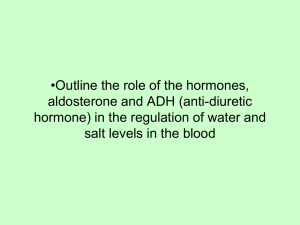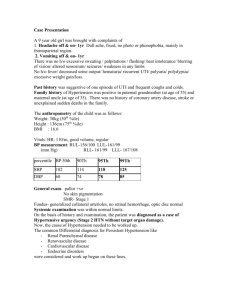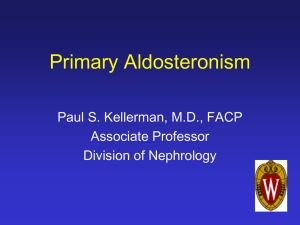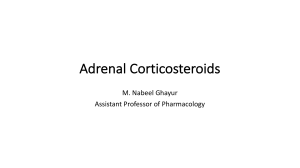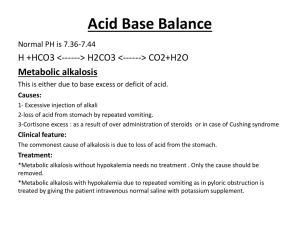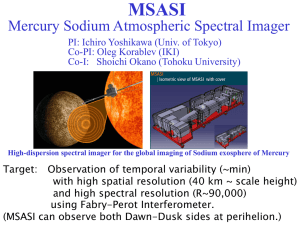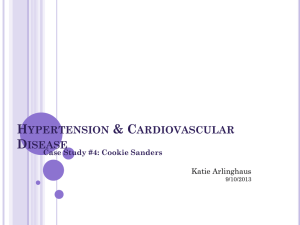Mineralocorticoid Excess Hyperaldostronism
advertisement
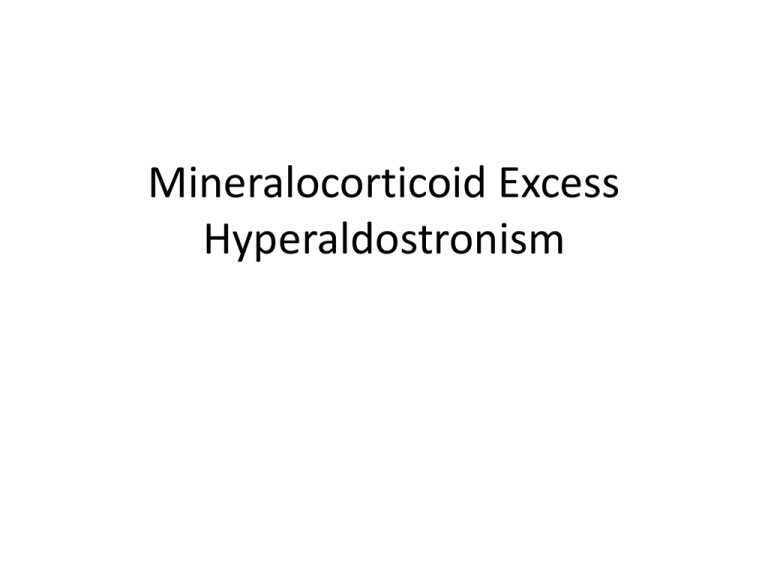
Mineralocorticoid Excess Hyperaldostronism Epidemiology • first description of a patient with an aldosterone-producing adrenal adenoma (Conn's syndrome) • mineralocorticoid excess was thought to represent a rare cause of hypertension • a much higher prevalence is now recognized, ranging from 5 to 12% • The prevalence is higher when patients are preselected for hypokalemic hypertension • The most common cause of mineralocorticoid excess is primary hyperaldosteronism, reflecting excess production of aldosterone by the adrenal zona glomerulosa. Causes of Mineralocorticoid Excess Etiology • Bilateral micronodular hyperplasia is more common than unilateral adrenal adenomas • Bilateral adrenal hyperplasia is usually micronodular but can also contain larger nodules that might be mistaken for a unilateral adenoma. • rare instances, caused by an adrenocortical carcinoma. Causes of Mineralocorticoid Excess Clinical Manifestations • Excess activation of the mineralocorticoid receptor leads to potassium depletion and increased sodium retention, with the latter causing an expansion of extracellular and plasma volume. • Increased ENaC activity also results in hydrogen depletion that can cause metabolic alkalosis. • Aldosterone also has direct effects on the vascular system, where it increases cardiac remodeling and decreases compliance. • Aldosterone excess may cause direct damage to the myocardium and the kidney glomeruli, in addition to secondary damage due to systemic hypertension. • The clinical hallmark of mineralocorticoid excess is hypokalemic hypertension • serum sodium tends to be normal due to the concurrent fluid retention, which in some cases can lead to peripheral edema. • Hypokalemia can be exacerbated by thiazide drug treatment, which leads to increased delivery of sodium to the distal renal tubule, thereby driving potassium excretion. • Severe hypokalemia can be associated with 1. muscle weakness 2. overt proximal myopathy 3. even hypokalemic paralysis • Severe alkalosis contributes to muscle cramps and, in severe cases, can cause tetany Diagnosis • should be restricted to those who exhibit 1. hypertension associated with drug resistance 2. Hypokalemia 3. an adrenal mass 4. hypertension before the age of 40 years • The accepted screening test is concurrent 1. measurement of plasma renin and aldosterone 2. calculation of the aldosterone-renin ratio (ARR) • serum potassium needs to be normalized prior to testing. Screening Confirmatory Tests Intravenous Saline Infusion Test • Two liters of 0.9% sodium chloride solution is infused intravenously with an infusion pump over 4 hours with the patient recumbent. • Blood pressure and heart rate are monitored during the infusion. • At the completion of the infusion, blood is drawn for measurement of PAC. 1. normal subjects :PAC levels decrease to less than 5 ng/dL, 2. primary aldosteronism : more than 10 ng/dL. 3. Indeterminate : PAC values between 5 and 10 ng/dL Oral Sodium Loading Test • hypertension and hypokalemia controlled • high-sodium diet (supplemented with sodium chloride tablets if needed) for 3 days, with a goal sodium intake of 5000 mg (equivalent to 218 mEq of sodium or 12.8 g sodium chloride • On the third day of the highsodium diet, a 24-hour urine specimen is collected for measurement of aldosterone, sodium, and creatinine. • Urinary aldosterone excretion of more than 12 μg/24 hours is consistent with autonomous aldosterone secretion Fludrocortisone Suppression Test • fludrocortisone acetate is administered for 4 days (0.1 mg every 6 hours) in combination with sodium chloride tablets (2 g three times daily with food). • Blood pressure and serum potassium levels must be monitored daily. • In the setting of low PRA, failure to suppress the upright 10 a.m. PAC to less than 6 ng/dL on day 4 is diagnostic of primary aldosteronism Localization Adrenal Venous Sampling • cortisol-corrected aldosterone lateralization ratios greater than 4.0: unilateral source of aldosterone like APA 95% sensitivity and 100% specificity • zone of overlap :ratios greater than 3.0 but less than 4.0 represent • bilateral aldosterone secretion : Ratios less than 3.0 Treatment • Patients younger than 40 years with confirmed mineralocorticoid excess and a unilateral lesion can go straight to surgery • Laparoscopic adrenalectomy is the preferred approach. • Patients who are not surgical candidates, or with evidence of bilateral hyperplasia based on CT or AVS, should be treated medically Medical treatment mineralocorticoid receptor antagonist • Spironolactone: started at 12.5–50 mg bid and titrated up to a maximum of 400 mg/d to control blood pressure and normalize potassium. • Side effects include 1. menstrual irregularity 2. decreased libido 3. gynecomastia • eplerenone : more selective MR antagonist . Doses start at 25 mg bid and it can be titrated up to 200 mg/d. • Another useful drug is the sodium channel blocker amiloride (5–10 mg/bid).


